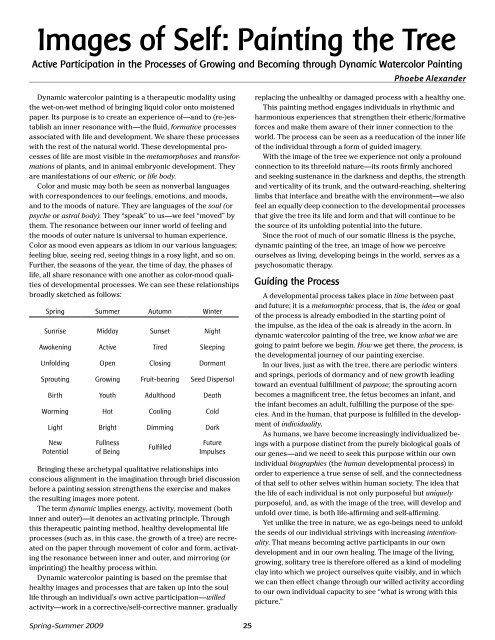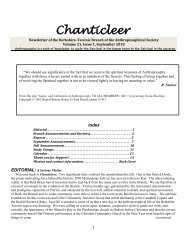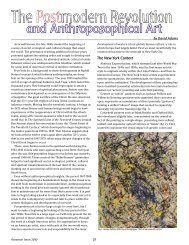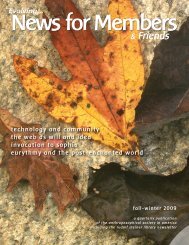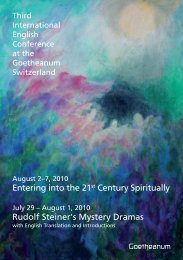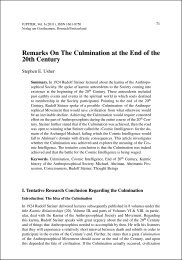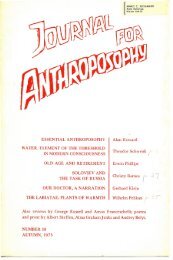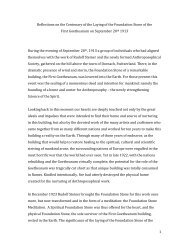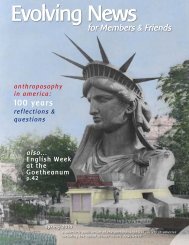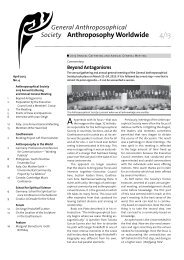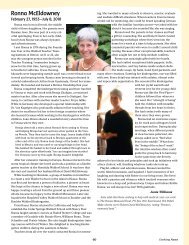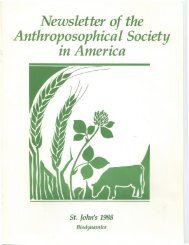Download - Anthroposophical Society in America
Download - Anthroposophical Society in America
Download - Anthroposophical Society in America
Create successful ePaper yourself
Turn your PDF publications into a flip-book with our unique Google optimized e-Paper software.
Images of Self: Pa<strong>in</strong>t<strong>in</strong>g the TreeActive Participation <strong>in</strong> the Processes of Grow<strong>in</strong>g and Becom<strong>in</strong>g through Dynamic Watercolor Pa<strong>in</strong>t<strong>in</strong>gPhoebe AlexanderDynamic watercolor pa<strong>in</strong>t<strong>in</strong>g is a therapeutic modality us<strong>in</strong>gthe wet-on-wet method of br<strong>in</strong>g<strong>in</strong>g liquid color onto moistenedpaper. Its purpose is to create an experience of—and to (re-)establishan <strong>in</strong>ner resonance with—the fluid, formative processesassociated with life and development. We share these processeswith the rest of the natural world. These developmental processesof life are most visible <strong>in</strong> the metamorphoses and transformationsof plants, and <strong>in</strong> animal embryonic development. Theyare manifestations of our etheric, or life body.Color and music may both be seen as nonverbal languageswith correspondences to our feel<strong>in</strong>gs, emotions, and moods,and to the moods of nature. They are languages of the soul (orpsyche or astral body). They “speak” to us—we feel “moved” bythem. The resonance between our <strong>in</strong>ner world of feel<strong>in</strong>g andthe moods of outer nature is universal to human experience.Color as mood even appears as idiom <strong>in</strong> our various languages;feel<strong>in</strong>g blue, see<strong>in</strong>g red, see<strong>in</strong>g th<strong>in</strong>gs <strong>in</strong> a rosy light, and so on.Further, the seasons of the year, the time of day, the phases oflife, all share resonance with one another as color-mood qualitiesof developmental processes. We can see these relationshipsbroadly sketched as follows:Spr<strong>in</strong>g Summer Autumn W<strong>in</strong>terSunrise Midday Sunset NightAwaken<strong>in</strong>g Active Tired Sleep<strong>in</strong>gUnfold<strong>in</strong>g Open Clos<strong>in</strong>g DormantSprout<strong>in</strong>g Grow<strong>in</strong>g Fruit-bear<strong>in</strong>g Seed DispersalBirth Youth Adulthood DeathWarm<strong>in</strong>g Hot Cool<strong>in</strong>g ColdLight Bright Dimm<strong>in</strong>g DarkNewPotentialFullnessof Be<strong>in</strong>gFulfilledFutureImpulsesBr<strong>in</strong>g<strong>in</strong>g these archetypal qualitative relationships <strong>in</strong>toconscious alignment <strong>in</strong> the imag<strong>in</strong>ation through brief discussionbefore a pa<strong>in</strong>t<strong>in</strong>g session strengthens the exercise and makesthe result<strong>in</strong>g images more potent.The term dynamic implies energy, activity, movement (both<strong>in</strong>ner and outer)—it denotes an activat<strong>in</strong>g pr<strong>in</strong>ciple. Throughthis therapeutic pa<strong>in</strong>t<strong>in</strong>g method, healthy developmental lifeprocesses (such as, <strong>in</strong> this case, the growth of a tree) are recreatedon the paper through movement of color and form, activat<strong>in</strong>gthe resonance between <strong>in</strong>ner and outer, and mirror<strong>in</strong>g (orimpr<strong>in</strong>t<strong>in</strong>g) the healthy process with<strong>in</strong>.Dynamic watercolor pa<strong>in</strong>t<strong>in</strong>g is based on the premise thathealthy images and processes that are taken up <strong>in</strong>to the soullife through an <strong>in</strong>dividual’s own active participation—willedactivity—work <strong>in</strong> a corrective/self-corrective manner, graduallyreplac<strong>in</strong>g the unhealthy or damaged process with a healthy one.This pa<strong>in</strong>t<strong>in</strong>g method engages <strong>in</strong>dividuals <strong>in</strong> rhythmic andharmonious experiences that strengthen their etheric/formativeforces and make them aware of their <strong>in</strong>ner connection to theworld. The process can be seen as a reeducation of the <strong>in</strong>ner lifeof the <strong>in</strong>dividual through a form of guided imagery.With the image of the tree we experience not only a profoundconnection to its threefold nature—its roots firmly anchoredand seek<strong>in</strong>g sustenance <strong>in</strong> the darkness and depths, the strengthand verticality of its trunk, and the outward-reach<strong>in</strong>g, shelter<strong>in</strong>glimbs that <strong>in</strong>terface and breathe with the environment—we alsofeel an equally deep connection to the developmental processesthat give the tree its life and form and that will cont<strong>in</strong>ue to bethe source of its unfold<strong>in</strong>g potential <strong>in</strong>to the future.S<strong>in</strong>ce the root of much of our somatic illness is the psyche,dynamic pa<strong>in</strong>t<strong>in</strong>g of the tree, an image of how we perceiveourselves as liv<strong>in</strong>g, develop<strong>in</strong>g be<strong>in</strong>gs <strong>in</strong> the world, serves as apsychosomatic therapy.Guid<strong>in</strong>g the ProcessA developmental process takes place <strong>in</strong> time between pastand future; it is a metamorphic process, that is, the idea or goalof the process is already embodied <strong>in</strong> the start<strong>in</strong>g po<strong>in</strong>t ofthe impulse, as the idea of the oak is already <strong>in</strong> the acorn. Indynamic watercolor pa<strong>in</strong>t<strong>in</strong>g of the tree, we know what we arego<strong>in</strong>g to pa<strong>in</strong>t before we beg<strong>in</strong>. How we get there, the process, isthe developmental journey of our pa<strong>in</strong>t<strong>in</strong>g exercise.In our lives, just as with the tree, there are periodic w<strong>in</strong>tersand spr<strong>in</strong>gs, periods of dormancy and of new growth lead<strong>in</strong>gtoward an eventual fulfillment of purpose; the sprout<strong>in</strong>g acornbecomes a magnificent tree, the fetus becomes an <strong>in</strong>fant, andthe <strong>in</strong>fant becomes an adult, fulfill<strong>in</strong>g the purpose of the species.And <strong>in</strong> the human, that purpose is fulfilled <strong>in</strong> the developmentof <strong>in</strong>dividuality.As humans, we have become <strong>in</strong>creas<strong>in</strong>gly <strong>in</strong>dividualized be<strong>in</strong>gswith a purpose dist<strong>in</strong>ct from the purely biological goals ofour genes—and we need to seek this purpose with<strong>in</strong> our own<strong>in</strong>dividual biographies (the human developmental process) <strong>in</strong>order to experience a true sense of self, and the connectednessof that self to other selves with<strong>in</strong> human society. The idea thatthe life of each <strong>in</strong>dividual is not only purposeful but uniquelypurposeful, and, as with the image of the tree, will develop andunfold over time, is both life-affirm<strong>in</strong>g and self-affirm<strong>in</strong>g.Yet unlike the tree <strong>in</strong> nature, we as ego-be<strong>in</strong>gs need to unfoldthe seeds of our <strong>in</strong>dividual striv<strong>in</strong>gs with <strong>in</strong>creas<strong>in</strong>g <strong>in</strong>tentionality.That means becom<strong>in</strong>g active participants <strong>in</strong> our owndevelopment and <strong>in</strong> our own heal<strong>in</strong>g. The image of the liv<strong>in</strong>g,grow<strong>in</strong>g, solitary tree is therefore offered as a k<strong>in</strong>d of model<strong>in</strong>gclay <strong>in</strong>to which we project ourselves quite visibly, and <strong>in</strong> whichwe can then effect change through our willed activity accord<strong>in</strong>gto our own <strong>in</strong>dividual capacity to see “what is wrong with thispicture.”Spr<strong>in</strong>g-Summer 200925


